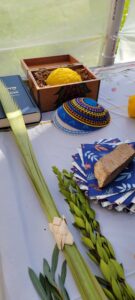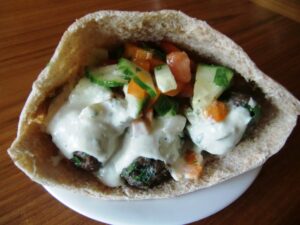With the solemn holidays of Rosh Hashana and Yom Kippur behind us, it’s time to start planning the celebration of Sukkot – Z’man Simchatenu – Time of our Rejoicing. This year it feels hard, almost impossible, to even begin celebrating Sukkot, knowing that the last day, Shemini Atzeret and Simchat Torah, is the yartzeit – the one-year anniversary of the horrific massacre in Israel. Nevertheless, we must at least observe the holiday, even with our heavy hearts.
Dwell in the Sukkah: One of the commandments of Sukkot is to “dwell in the sukkah.” We build this temporary dwelling, barely a shelter from the elements, and live in it for the whole week. Some people like to sleep in their sukkah, but the rabbis agreed that eating meals there counts as “dwelling.”
The sukkah represents the temporary shelters used by the Israelites as we wandered through the desert after leaving Egypt. The relatively flimsy construction of the sukkah also reminds us of the fragility of our existence – how lucky we are and how quickly our fortunes can change.
The agricultural symbolism of the sukkah is often overlooked. Farmers erected simple structures to sleep in the fields during the harvest. In part, they stayed close to their precious crops to protect them from thieves and animals, but they also didn’t want to waste any time before the weather turned bad or crops spoiled.
If you don’t put up your own sukkah and don’t get invited to one, I encourage you to take a bag lunch (dairy or parve, please) to a nearby synagogue sukkah to enjoy at least one meal surrounded by the trappings of this joyous holiday. Please call ahead to let them know you’re coming.

Lulav & Etrog: The second commandment of Sukkot is to shake the Lulav & Etrog or Arba Minim (Four Species) every day. One interpretation compares the four species to parts of the human body: lulav (palm) for the spine, myrtle for eyes, willow for the mouth, and etrog for the heart. We are reminded to be strong yet flexible like the lulav, truly see and pay attention to the world around us, speak carefully and kindly, and approach life with love. Again, if you do not have your own lulav and etrog, any synagogue or day school should let you use theirs and help you with the process and prayer.
Round Challah and Honey: Our family has a tradition that begins on Rosh Hashana, when we have round challah dipped in honey. We continue to use only round challah from Rosh Hashana through the end of Sukkot, and we dip in honey instead of salt the whole time. This practice helps cement a feeling of a full “holiday season” of celebration.
Foods for Sukkot: There aren’t any strictly traditional Sukkot foods like latkes for Hannukah or cheesecake for Shavuot. Because of the holiday’s agricultural connection, it makes sense to enjoy the bounty just coming into season. We are still seeing the last of summer’s tomatoes and corn. Autumn’s squashes, root vegetables, hearty greens, apples, pears, cranberries, and figs offer unlimited opportunities for delicious, easy, sukkah-appropriate meals.
Here’s a tip. The closer your sukkah is to your kitchen, the easier it is to serve hot meals in it. If there is a long walk or a set of stairs between the kitchen and the sukkah, set up hot food in the kitchen and let everyone fix and carry their own plate. Serve soup in mugs. If you want to serve in the sukkah, carrying cold-cut platters, myriad salads, and loaves of bread is safer.
Some people prepare “stuffed” dishes to represent the full bounty of the harvest season. Stuffed cabbage and peppers are good choices, but you can stuff chicken breasts, acorn squash, ravioli, or strudels.
I always serve at least one typical Israeli meal in the sukkah, and this year, I think it’s especially important to do so. We’re all familiar with Israeli street food like falafel or shawarma served in fresh pita with salads, pickles, sauces, and fries.
Make Chicken Shawarma: Rub boneless chicken thighs with olive oil and shawarma seasoning, roast in a 350° oven until barely cooked through. (You can do this early in the day.) When it’s just about time to eat, chop the chicken into small pieces. Crisp the chicken up in a hot skillet with a little vegetable oil. Toss in a pita with hummus, tehina, Israeli salad and pickles, and some harissa or other hot sauce.
The key to an authentic Israeli meal is always the pita. It’s not that hard to make and it’s the most surefire way to guarantee a warm, fluffy pita that opens to a deep pocket, sturdy enough to hold all the goodies inside. Israeli chef Adeena Sussman offers a pretty easy way to make pita in your oven. Here’s the link.
Israeli Kabobs
Makes 16 small kabobs. Count on 2-4 per person, depending on the rest of the menu. Serve in pita with fresh Israeli Salad, hummous, tehina, olives, and Israeli pickles. You can substitute ground lamb, turkey, or chicken for all or some of the beef. If using ground turkey or chicken, add 1 tablespoon olive oil to the mix.
These kabobs are easy to make ahead and freeze until you need them – either for a quick meal or for a gathering. They can be finished in the oven or on the grill. Even if you’re eating the same day or the next, par-baking them in the oven prevents sticking on the grill.

Ingredients
- 1 lb ground beef
- 1 C parsley, chopped
- 2 TBSP cumin
- 1-2 garlic cloves, chopped very fine
- 1/2 TBSP kosher salt
- 2 TBSP cold water
Directions
- In a large bowl, combine all the ingredients. Use your hands to mix it up thoroughly.
- Divide into 16 portions. Form each into sort of a short hot dog shape, about the length of your pinky.
- Place on baking sheet; bake at 350° for 8 minutes; 4 minutes per side.
- At this point, you can let the kabobs cool and freeze them in single layers, separated by parchment paper, in a tightly sealed container. On the day of the party, let thaw before grilling.
- Grill kabobs over a medium flame for about 5 minutes.
Click here to print the Israeli Kabobs recipe.
Here are links to a few more Israeli-style recipes: Israeli Salad | Tehina | Chicken Skewers



1 comment